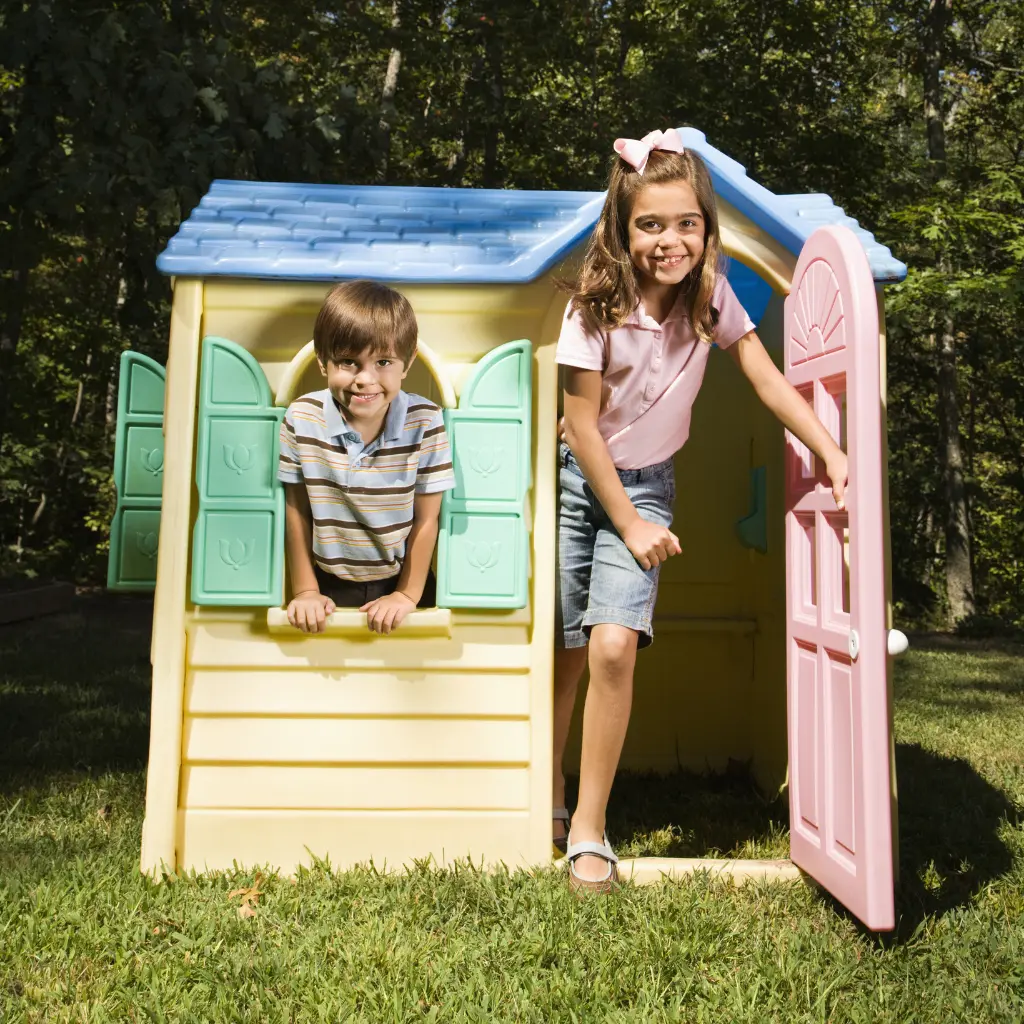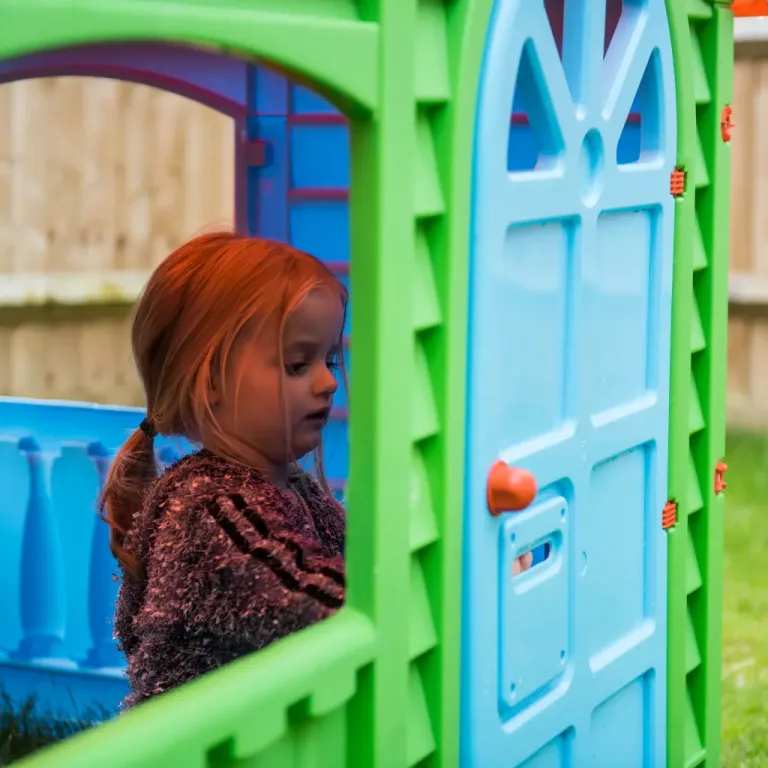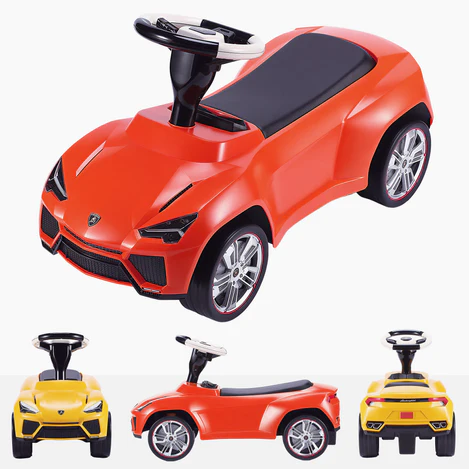Creating the perfect outdoor play space for our little ones involves decisions that feel as significant as choosing between a cosy cabin or a modern retreat.
It’s not just about selecting a play area; it’s about shaping childhood memories and fostering development in environments that encourage creativity, physical activity, and social interaction.
As we navigate the nuances of choosing between plastic and wooden playhouses, it’s essential to consider not only the immediate appeal but also the long-term benefits for our children’s growth and learning.
To understand the profound impact playhouses can have on children’s development, consider the insights provided by this article on the importance of playhouses for children’s development.
It highlights how these seemingly simple structures can significantly contribute to cognitive, social, and motor skills development.
Playhouses offer a unique environment where children can engage in imaginative play, which is crucial for emotional and intellectual growth.
The outdoor toy scene in the UK has really taken off, showing a whopping 29.3% jump in sales and folks spending a cool £7.7M back in April 2020.
Looks like the lockdown has got more of us turning our gardens into playgrounds, doesn’t it?
Let’s explore the nuances of each option—plastic and wooden playhouses—to ensure you make the most informed decision for your family.
By delving into the characteristics of both materials, we can uncover which type of playhouse not only suits your immediate needs but also aligns with your long-term goals for your children’s development and environmental sustainability.
Table of Contents
ToggleMaterial, Durability, and Safety Considerations
Plastic Playhouses: Lightweight Champions or Fleeting Fun?
Plastic playhouses, often celebrated for their vibrant colours and ease of assembly, bring a modern twist to the backyard. Their lightweight nature makes them a breeze to move from one corner of the garden to another.
Resistant to rain and generally unfazed by the changing seasons, these playhouses seem like a hassle-free choice. However, it’s not all sunny skies.
Over time, exposure to the elements can lead to cracks or sun damage, potentially shortening their lifespan and raising questions about long-term value.
Diving into the fun universe of outdoor playhouses?
It’s always cool to stay on top of the latest toy trends – they can give us some pretty neat ideas.
Want to see what’s hot right now?
Check out The Top Toy Trends for some inspiration!
Wooden Playhouses: Sturdy Sanctuaries or Maintenance Heavy Havens?
On the flip side, wooden playhouses stand as sturdy sanctuaries, exuding a timeless charm that blends seamlessly with nature.
Their robust construction promises durability, but this comes with a caveat—maintenance.
To keep these wooden wonders looking their best, regular treatments are required to ward off wear from weather and pests.
Safety-wise, while both options come with their own set of concerns, such as the potential for splinters from wood or chemicals in plastic, modern treatments and manufacturing standards strive to mitigate these risks.
In addition to selecting the right playhouse, incorporating STEM toys into your child’s play area can further enhance their learning experience.
Learn about STEM toys at What Are STEM Toys.
Ease of Assembly
When it comes to assembling your playhouse, the material plays a big role in how your weekend project shapes up.
Plastic playhouses are like the friendly puzzle pieces of the outdoor toy world—snap a few large parts together, and voilà, you’re the hero of the hour.
Wooden playhouses, while offering that undeniable charm, can turn into a more involved DIY project. Think of it as a bonding opportunity, or perhaps a test of patience, requiring tools, time, and a bit of carpentry know-how.
Either way, the sense of accomplishment is guaranteed, but your choice might depend on how much of a DIY enthusiast you are.
Longevity and Resale Value
Looking at playhouses as an investment, wooden options often come out ahead in the longevity race, assuming they’re well-maintained.
This durability can translate into better resale value down the line, offering some return on your investment.
Plastic playhouses, while initially more budget-friendly, may not hold their value as long, especially if they’ve braved a few seasons of harsh weather.
It’s a consideration for those thinking about the playhouse’s life cycle—from assembly to passing it on when your kids have outgrown their magical backyard retreat.
Aesthetics, Adaptability, and Customisation
A Visual Feast or a Blending Background?
When it comes to aesthetics, wooden playhouses often steal the show with their classic look, offering a piece of timeless beauty in your backyard.
They offer a canvas for creativity, allowing you and your children to paint, decorate, and personalize your little haven.
Plastic playhouses, though limited in customisation, bring a pop of color and whimsical shapes that can captivate the young imagination.
Customisation: A Personal Touch
The ability to add personal touches—be it through painting, adding fixtures, or even a flower box—makes wooden playhouses a favorite for those looking to create a truly unique play space.
Plastic playhouses, with their predetermined colors and shapes, offer less room for such personalisation but are nevertheless a cheerful and inviting option for play.
Customising playhouses can spark children’s imagination, much like open-ended toys, which offer endless possibilities for play.
Discover the benefits of open-ended toys at What Are Open-Ended Toys.
Integration with Outdoor Spaces
Your backyard is more than just a space; it’s an extension of your home. Wooden playhouses, with their natural materials, can blend seamlessly into your garden or outdoor area, enhancing its overall aesthetic.
They’re like that rustic bench that just belongs. Plastic playhouses, on the other hand, offer a burst of color and modern shapes that can stand out, adding a vibrant touch to your outdoor decor.
The choice here depends on whether you’re looking for a playhouse to complement your garden’s look or one that pops with color and fun shapes.
Environmental Impact and Sustainability
The environmental impact of our choices has never been more pertinent.
Wooden playhouses, sourced from sustainable forests, offer a nod to eco-friendliness that plastic alternatives struggle to match.
While wood can return to the earth from whence it came, plastic’s longevity in our ecosystem is a growing concern.
Moreover, the possibility of repurposing or reselling wooden playhouses provides an additional layer of sustainability, reducing waste and extending the life of the playhouse beyond its initial use.
Recycling and Disposal
Eventually, there comes a time to say goodbye to the playhouse, whether it’s due to your kids outgrowing it or a move.
Wooden playhouses, especially those made from untreated, natural wood, can be easier to recycle or repurpose, perhaps finding a second life as garden decor or even as materials for another project.
Plastic playhouses, while not as straightforward to recycle, shouldn’t just be tossed aside.
Many communities offer recycling programs for large plastic items, ensuring that the playhouse’s final chapter is as environmentally friendly as its years of service in your backyard.
Cost, Accessibility, and Value
The Price of Play
Initially, plastic playhouses may appear more wallet-friendly, with prices that often undercut their wooden counterparts.
However, when considering longevity and durability, wooden playhouses might offer more bang for your buck in the long run.
While the upfront cost is higher, their ability to withstand the test of time—and even grow with your family—presents a compelling argument for their value.
Parents and educators are key purchasers of outdoor toys, with a focus on balancing screen-time with outdoor play to keep children connected to the natural world.
When considering the purchase of a playhouse, online shopping can be a convenient option.
For insider tips on making the best toy purchases online, visit Insider Tips for Toy Shopping Online.
Availability and Accessibility
Both plastic and wooden playhouses are readily available, but the ease of installation varies.
Plastic playhouses can often be assembled with minimal fuss, while wooden structures might require a bit more elbow grease or even professional help.
This difference is something to consider, especially if you’re looking for a quick setup.
Hidden Costs
The sticker price of the playhouse is just the beginning.
With wooden playhouses, consider the cost of maintenance, from stains and seals to repairs from the occasional wayward football.
Plastic playhouses, seemingly low-maintenance, aren’t without their surprises—fading colours and potential for cracks mean you might be looking at replacements sooner than expected.
These hidden costs are worth pondering as they add up over the years, influencing not just your budget but also the playhouse’s appeal and functionality.
Conclusion
As we’ve journeyed through the considerations of choosing the perfect playhouse, it’s clear that both plastic and wooden options have their merits and drawbacks.
The decision ultimately hinges on your family’s specific needs, preferences, and values.
Whether you lean towards the eco-friendly charm of wooden playhouses or the vibrant, low-maintenance appeal of plastic ones, the goal is the same: creating a safe, enjoyable outdoor space where your children can play, explore, and make memories.
Remember, the best playhouse is not just about material or cost; it’s about the laughter, adventures, and moments of wonder it will host.
So, consider your options, make your choice, and then step back to watch your little ones embark on a journey of imagination right in your backyard.
FAQs
When choosing the size of a playhouse, consider both the available space in your garden and the age of your children. Measure the area where you plan to place the playhouse to ensure a good fit, allowing extra space around it for accessibility. For younger children, smaller playhouses are often sufficient, while older children might appreciate more room to play and grow. Remember, a playhouse that’s too large for your garden can overwhelm the space, while one too small may quickly become outgrown by your children.
Playhouses can be enjoyed year-round, but their usability in various seasons depends on their construction and material. Wooden playhouses, with proper weatherproofing, can provide a cozy retreat even in cooler months. Adding insulation can extend their use into the colder seasons. Plastic playhouses, though less susceptible to weather conditions, might not be as comfortable in the winter. Consider the climate in your area and whether you plan to adapt the playhouse for seasonal use when making your choice.
Yes, many playhouses are designed with adaptability in mind. Look for playhouses with adjustable features, such as removable doors, windows, or even walls that can be expanded. Modular wooden playhouses can be particularly suitable for this, as additional sections can be added as your child grows. Choosing a playhouse that offers the flexibility to adapt to your child’s changing needs and interests can provide a lasting and evolving source of fun and learning.
Safety is paramount when selecting a playhouse. Look for products that comply with relevant safety standards, such as the EN71 for toy safety in Europe, which covers aspects like structural integrity, materials used, and the absence of harmful chemicals. Ensure the playhouse has smooth edges, secure fastenings, and, if wooden, is treated with child-safe preservatives. Checking for certifications or asking retailers about compliance with safety standards can help ensure you choose a playhouse that’s not only fun but also safe for your children.



